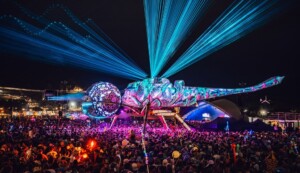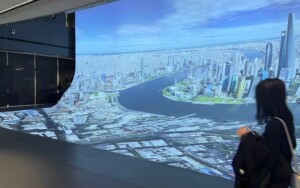International audio-visual company Electrosonic have supplied and installed pioneering interactive exhibits for the new Dinosaur Hall in the Natural History Museum of Los Angeles County. Visitors to the museum can now enjoy a unique experience whilst learning more about the prehistoric creatures in the 14, 000 square foot display.
This includes the world’s only T-Rex “growth series” of infant, juvenile and adult skeletons, which are presented on modern platforms with interactive touchscreen audio-visuals which fully complement the displays without being over the top.
Related: Electrosonic Profile / Audiovisual technology: A short history of the videowall / Electrosonic: Sinus – Systems Integration Award for Parliamentarium at Prolight & Sound
Electrosonic were asked to provide all of the audio-visual technology and to ensure it was high-quality and didn’t threaten to overwhelm the creatures on display. Touchscreens are placed strategically around the displays, some embedded into the walls, some stand-alone and others at the base of individual exhibits. These include interactive video and graphic panels in order to allow visitors to learn all about the bones on display.
 “In the Hall, the dinosaurs are the stars. You don’t want to compete with the T. rex – people are there to see the bones, ” says Electrosonic design consultant Steve Coe.
“In the Hall, the dinosaurs are the stars. You don’t want to compete with the T. rex – people are there to see the bones, ” says Electrosonic design consultant Steve Coe.
The audio-visual design presented something of a challenge to the Electrosonic team, especially when it came to building the interactive computers into the bases. This minimized the use of “extenders”, which would have been necessary had they been located in the equipment room on the third floor.
“It was more efficient and reliable to hide the content players in the exhibit than position them in a remote location, ” says Coe.
A Christie HD10K-M series projector was used for the 15-foot wide projection screen, which greets visitors as they walk past the Triceratops and 68-foot Mamenchisaurus displays. The screen plays a looped video titled “Investigating Dinosaurs” which describes the hunt for them and two Renkus-Heinz speakers are located at the rear of the screen.
“The challenge for this display was how to project from the ceiling-mounted Christie over the neck of the Mamenchisaurus and onto the other wall, ” says Coe. “It was difficult to figure out, and we only cleared the neck by a few inches.”
Below the screen, two ELO touchscreens have been installed which allow guests to zoom in on individual bones and rotate them on-screen. These complement the 43-foot fossil wall which showcases 100 prehistoric specimens.
On the mezzanine level, a number of exhibits feature Electrosonic’s unique audio-visual components, one of them being an interactive touchscreen that allows visitors the ability to simulate dinosaur calls. This was achieved using a flat Innovox full-range speaker which gives a low-end range suitable for dialogue; dinosaur calls are much lower in range than other animals.
All of the interactives are powered by Dell computers which were supplied by Electrosonic, who also implemented BSS London BLU audio signal processing and Medialon Showmaster show controls connects to all audio-visual points.
Electrosonic’s Steve Coe says that the Dinosaur Hall has been “packed” since opening and the venue has been experiencing long entry queues.













